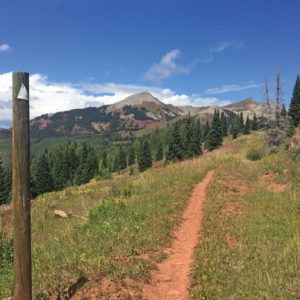By Brad Klafehn
There’s a pipeline which runs through Central Colorado. Known best to its owners and maintainers, it unobtrusively carries an invisible commodity north and south. Not oil, natural gas, or carbon dioxide, it carries the hopes and aspirations of a class of active dreamers who take to foot and wheel on long-distance journeys of discovery and self-discovery. This is the Continental Divide Trail (CDT), which attracts self-powered visionaries to our area from Colorado and around the world.
Starting in March, the flow runs south to north, as the New Mexican desert heats up. After an often arduous trial by snow in the San Juan Mountains, the northbound payload arrives here at the start of summer, timing their tracks to avoid snow drifts in the fall in the northern Rockies. Later in the summer, the pipeline reverses itself, flowing down from Canada starting in mid- to late June, as the southbound try to beat our own fall snowstorms, arriving in Mexico in November.

On a bluebird Colorado day in the Collegiates in September 2017, ten or so of these seekers were passing through, singly and in small groups. A small minority seemed disheveled and disoriented, staggering along the pipeline, pant flys open, speaking of losing their way and of the coldness of the Colorado night. The majority were remarkably clear-eyed, with broad smiles. Of those, although looking like a fairly nondescript young man, in conversation one stood out, a self-described “very happy, optimistic, outgoing person” – Blake.
Some years ago, after completing a through-hike of the Appalachian Trail and seeing others complete the amazing feat of hiking the “Triple Crown” (the Appalachian Trail, CDT, and Pacific Crest Trail) in a single year, he felt the urge to do something else remarkable, but which had never been done before. He dreamed of a self-powered solo journey visiting all the National Parks in the lower 48, linking them by hiking and bicycle, a journey which would take three years and 20,000 miles to complete. He quit his job in Aspen, sold everything to finance his dream trip, created “walktheparks.com,” and set off, starting in Yellowstone, our first National Park, at Old Faithful. This day, he was on foot about to drop into Chalk Creek on his way to the Great Sand Dunes. Planning to stop at schools and newspapers along the way to spread his message that you can dream big and achieve things no one else has, Blake gave a contact high to at least one fellow traveler that day.
Though expansive and open to the sky, this transnational pipeline is nonetheless a compression reactor in which the physical and mental difficulties of extended exertion combine to create new and interesting by-products. Especially for the solo traveler, hours and days are spent in silence, with the wind, the birds, and one’s thoughts for companions. Physical discomfort and mental distress can alternatively lead to abandoning the hike, or to unexpected insights and spiritual revelations.
[InContentAdTwo]
I’ve often noted on hikes that “the last mile is the hardest,” as the accumulated wear on feet and back combine with visions of cheeseburgers to make the last mile an agony of anticipated completion which seems to go on forever. But this time, after (only) five days in the pipeline, something else emerged. While feeling pains which had previously been suppressed by the sheer need to reach the seemingly far-away end of the trip, came a revelation. The last mile was truly only one more out of the hundred I had already done, so why should my attitude to it be any different, especially when that attitude was essentially self-defeating? Treat it like any other mile, because it is. With that thought, I was able to forget my frustration and resume marveling at the electric green moss in the crevice of the rock I had just stepped over and the vibrant yellow and orange of the aspen grove I was passing through. I focused again on the exact placement of my feet as I moved briskly through the landscape, lengthening my stride, without anticipation beyond the next step, but with a growing appreciation of all the steps through beauty I had already taken that week.
The trailhead emerged unexpectedly quickly, just as the first snow of the season was beginning to fall. My last-mile phobia had disappeared, I was tremendously energized and ready, at least mentally, to go a hundred more.
Meanwhile, Blake and the others were still carrying on southward, through the freezing rain on journeys of discovery, through our backyard along a pipeline of dreams.
Note: Salida was officially deemed a Gateway Community for Continental Divide thru-hikers by the Continental Divide Trail Coalition in 2019. Gateway Communities are towns that recognize the unique economic and cultural value that the CDT brings. They make services available to hikers, educate local residents, and advocate for continued access to public lands. Communities comprise volunteers, business owners, public officials and land management partners.
You might find Brad Klafehn bent over in a Colorado State Park, removing invasive weeds so that the native plants can emerge from the seed bank – which they will, if given the chance.



I like the pipe line analogy. Wonder how many hike the CDT in an average year? Thank God for public lands!